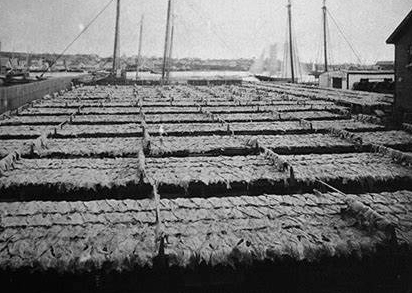
Cod dry in the sun on a flake, a platform built especially for the purpose and raised three or four feet off the ground. (Photo courtesy National Oceanic and Atmospheric Administration)
In the early 1500s the Portuguese reached supremacy of exploration of the North Atlantic. They learned of the wonderful fishing in the waters off the coast of Newfoundland. This does not mean that other countries did not go to the Grand Banks to get fish, but it was the Portuguese who were making the long trips in their rather small boats to harvest vast numbers of cod.
It is interesting that in early Colonial history very little attention was paid to North America by the English.
According to Samuel Eliot Morison in his book, “The European Discovery of America, the Northern Voyages,” English King Henry VIII claimed sovereignty over America but did nothing to “nail it down.”
The area was well known. European fishermen had been coming to the Newfoundland fishery for generations. No place in the world has ever been so rich in edible fish and other products of the seas as the Newfoundland Banks, the coast of Labrador, and the Gulf of St. Lawrence.
France and Spain were constantly at war with each other and England was going through its period of changing from Catholics to Protestants. Perhaps it was felt well to leave the present fishing to those who had always gone fishing there.
Elizabeth I became queen of England in 1558 and, in 1563, her Parliament passed a law declaring both Wednesday and Saturday to be fish days. England became a very good customer for fish. Of course, with the large Catholic population on the European continent, fish had always been in great demand. At that point coast of North America became far more interesting.
Cod is a name commonly given to the members of the family Gadidae, according to my encyclopedia. About seven of the 25 known genera are important as food. Cod were full of vitamins and a boon to the poor people of Europe.
That was what they came for but there were plenty of fish besides cod: haddock, pollock, halibut, flounders, among others. All could be cured, but to your 16th century fisherman “fish” meant codfish. Only cod would do. All others were thrown away or cut up for bait.
By the mid 16th century hundreds of boats were exploring the Grand Banks and the Newfoundland fisheries down the coast.
According to Morrison, in general there were two methods of cod fishing in American waters; “wet” and “dry.”
Those crews with a plentiful supply of salt, usually the French, Spanish, and Portuguese, salted their fish heavy enough so they just loaded their boats with fish and headed for home.
Dry fishing was usually done by the English and Dutch, with the Normans and Bretons pursuing both kinds. For dry fishing, the vessel brought out double crews, one to fish and one to work on shore. For dry fishing, the season started about May when capelin swarmed ashore and the cod followed them.
After mooring their boat well and harbor-furling her sails, for one way to catch the cod, barrels were lashed along the topsides, and a man in each barrel started pulling in the codfish and throwing them on deck to be gutted. Most of the fishing, however, was done from the fleet of small boats that each ship brought out, hauling the fish by landline.
Each ship carried an average of seven small boats with five men for each. Each small boat and crew was expected to fill the boat to the gunwales with cod by noon.
The shore crew, in the meantime, felled trees and put up a fish stage, a wharf projecting into the harbor, onto which the fishermen threw the codfish from the boats, to be gutted and split. More important, on the shore behind the wharf were built flakes. These were platforms of brush and small boughs raised some three or four feet above ground, on which the cod were dried.
Every night and in foggy or rainy weather, the split fish had to be covered with wood or sailcloth. If it were too hot, the fish had to be protected from the sun during the day. These flakes also had to be guarded against wandering animals and birds.
If properly cared for, in a matter of days, the fish were pronounced cured. They were then stored in a shed waiting for to be loaded onto a ship.
This is where we came in for it was found it paid to have a crew live at the shore all year around and be set up when the fishing boats arrived with their crews ready to fish or to load fish already cured to take home.
The final sun-cured codfish, called stock fish, became a delicious, savory morsel when soaked and properly cooked. In the 16th century, Monhegan Island was easy to find and it was safe from any Indian attacks. However, there was not enough space there. Each group wanted their own space and flakes. Living there all year brought the wives and children.
Villages were soon established along the shore and up the rivers. Cod fishing became the backbone of the New England fishing industry.
The English, who concentrated on dry fishing, were often successful as to make two or three shiploads of stock fish in one season.
It is of note that neither the men who fished nor the shore parties were paid wages. Instead, the profits were divided up into shares. The owner of the ship took one-third to one-half, the rest was divided among the men by agreed upon fractions.



